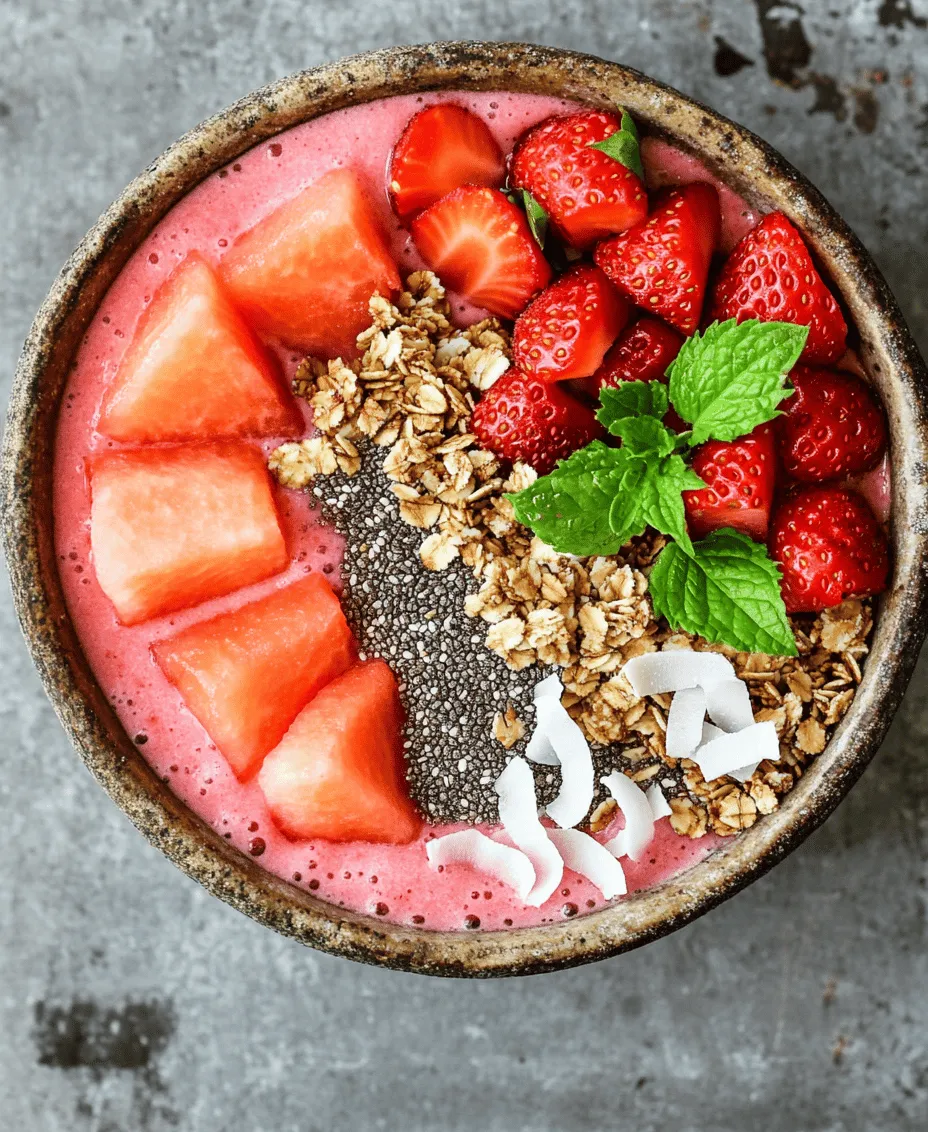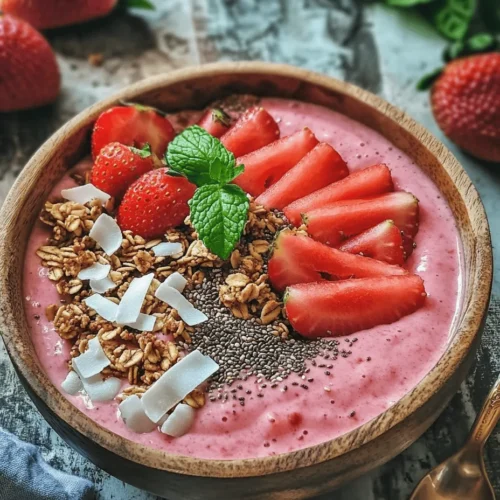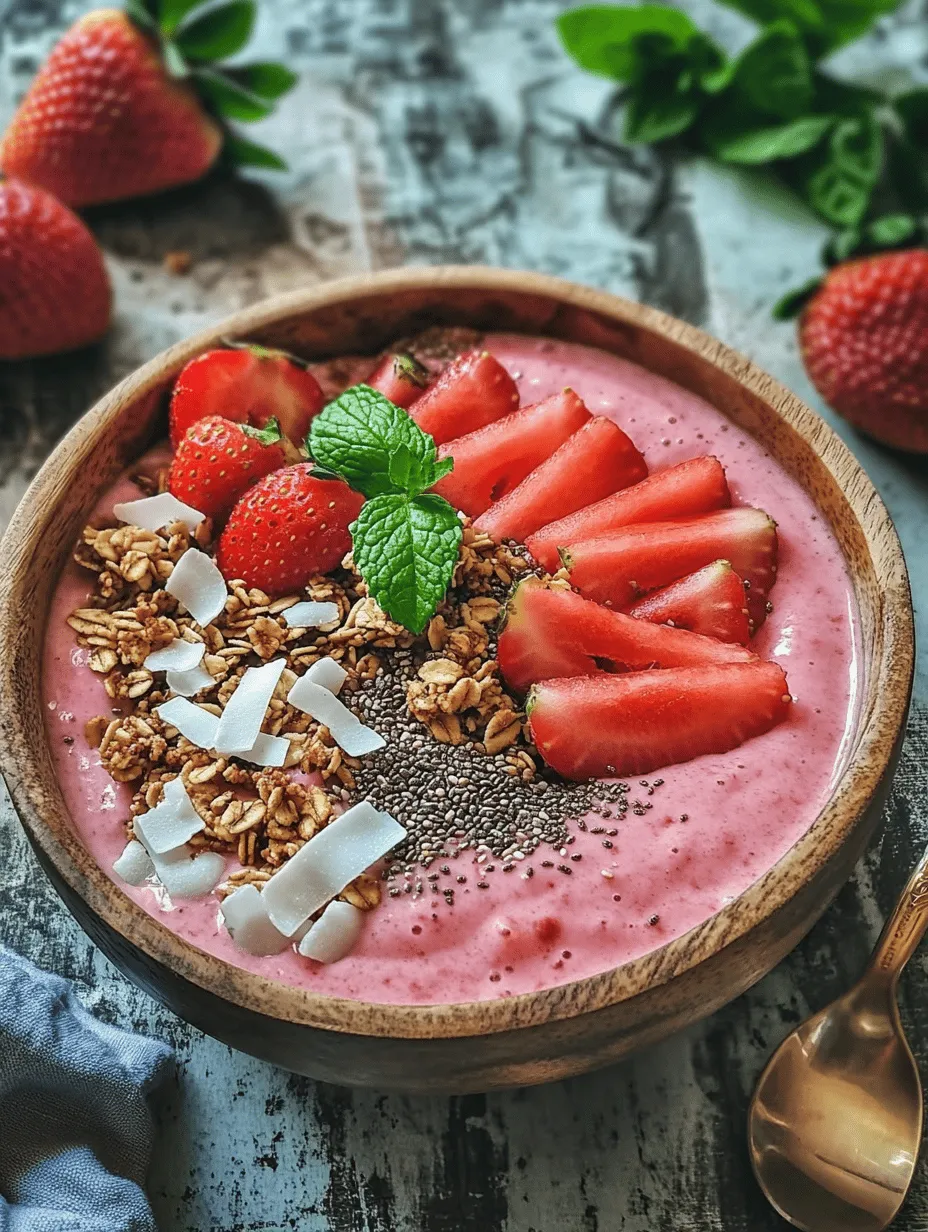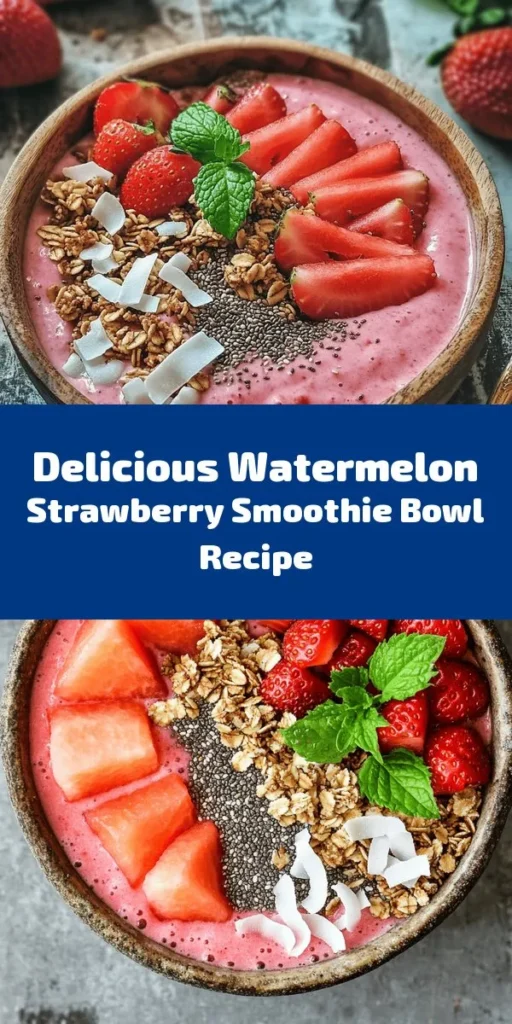Introduction to Watermelon and Strawberry Smoothie Bowls
In recent years, smoothie bowls have surged in popularity, becoming a staple in health-conscious diets and breakfast menus around the world. These vibrant and colorful dishes are not just visually appealing but also packed with essential nutrients, making them a perfect choice for anyone looking to start their day on a healthy note or seeking a refreshing snack. Among the myriad of smoothie bowl options available, the Watermelon and Strawberry Smoothie Bowl stands out as a delightful combination of taste, texture, and nutritional benefits.
Watermelon and strawberries are the stars of this recipe, offering a refreshing and hydrating base that is rich in vitamins and antioxidants. Watermelon, with its high water content, is not only thirst-quenching but also loaded with vitamins A and C, making it a powerful ally for skin health and immune support. Meanwhile, strawberries bring their own set of health benefits to the table. They are known for their high levels of antioxidants and vitamin C, which support heart health and overall wellness. This smoothie bowl, therefore, does not merely quench your thirst; it revitalizes your body with essential nutrients.
What makes this smoothie bowl even more appealing is its versatility. The recipe allows for easy customization based on personal taste preferences and dietary requirements. Whether you prefer a dairy-free option, want to add a protein boost, or simply enjoy experimenting with toppings, this Watermelon and Strawberry Smoothie Bowl can be adapted to suit your needs. It is not only quick to prepare but also encourages creativity in the kitchen, making it an ideal dish for breakfast, brunch, or even a midday pick-me-up.
Understanding the Ingredients
Creating a perfect Watermelon and Strawberry Smoothie Bowl begins with understanding the key ingredients that contribute to its delicious flavor and nutritional profile. Let’s break down the main components:
Fresh Fruits as the Foundation
Watermelon: Nutritional Benefits and Hydration
Watermelon is a summer favorite for good reason. This juicy fruit is composed of about 92% water, making it incredibly hydrating—a perfect choice for hot days or post-workout refreshment. Beyond hydration, watermelon is low in calories but high in nutrients. It contains significant amounts of vitamins A and C, which are essential for maintaining healthy skin and a robust immune system. Additionally, watermelon is a source of lycopene, an antioxidant associated with various health benefits, including reduced inflammation and improved heart health. When blended, watermelon adds a naturally sweet and refreshing flavor, setting the perfect base for your smoothie bowl.
Strawberries: Antioxidants and Flavor Profile
Strawberries are another powerhouse ingredient in this smoothie bowl. Not only do they add a burst of vibrant color, but they are also rich in antioxidants, particularly vitamin C and flavonoids, which help combat oxidative stress in the body. Strawberries are known to support heart health, improve blood sugar levels, and enhance skin health. Their natural sweetness pairs harmoniously with watermelon, creating a deliciously fruity blend that delights the palate. Moreover, strawberries are versatile; they can be used fresh, frozen, or even in various forms like puree, depending on your preferences.
Banana: Natural Sweetness and Creaminess
Adding a banana to the mix provides both natural sweetness and creaminess to the smoothie bowl. Bananas are an excellent source of potassium, which is crucial for maintaining healthy blood pressure and muscle function. They also contain dietary fiber, aiding digestion and helping you feel full longer. When blended, ripe bananas create a smooth and creamy texture that enhances the overall mouthfeel of the smoothie bowl, making it more satisfying and enjoyable.
The Role of Yogurt and Sweeteners
The addition of yogurt is what elevates this smoothie bowl from a simple drink to a hearty meal. Yogurt not only adds creaminess and depth of flavor but also contributes beneficial probiotics, which promote gut health.
Coconut Yogurt vs. Regular Yogurt: Benefits and Flavor Nuances
While traditional dairy yogurt is a popular choice, coconut yogurt has gained traction as a delicious dairy-free alternative. Coconut yogurt is made from the flesh of coconuts and offers a unique, slightly sweet flavor that complements the fruits in this recipe beautifully. It is also rich in healthy fats and can be a good source of probiotics, making it a great option for those following a vegan or lactose-free diet. On the other hand, regular yogurt—especially Greek yogurt—provides a protein boost and a creamy texture that many people enjoy. Choosing between the two depends on your dietary preferences and flavor goals.
Honey or Maple Syrup: Making It Your Own
To sweeten the smoothie bowl, you can opt for a drizzle of honey or maple syrup. Honey is known for its natural antibacterial properties and can enhance the flavor profile of the smoothie. Maple syrup, on the other hand, offers a distinct taste and is packed with antioxidants. Either option allows you to control the sweetness of your smoothie bowl and tailor it to your liking. For a sugar-free alternative, you might consider using a natural sweetener like stevia or agave syrup.
Liquid Base: Coconut Water or Regular Water
The liquid base is crucial in achieving the desired consistency for your smoothie bowl. It helps blend all the ingredients seamlessly while providing hydration.
The Importance of Liquid in Smoothie Bowls
Adding liquid not only facilitates blending but also impacts the overall texture of the smoothie bowl. Too little liquid can result in a thick, chunky mixture that is difficult to pour or spoon, while too much liquid can lead to a soupy consistency that lacks substance. Striking the right balance is key to achieving a deliciously creamy smoothie bowl.
Benefits of Using Coconut Water
For a tropical twist and additional electrolytes, consider using coconut water as your liquid base. Not only does it enhance the flavor, but it also provides hydration and essential electrolytes, making it an ideal post-workout beverage. Coconut water is low in calories and high in potassium, which can help replenish electrolytes lost during exercise. This makes it an excellent choice for those looking to enhance their smoothie bowl’s nutritional profile.
Step-by-Step Instructions for Preparation
Now that we have explored the ingredients, let’s dive into the preparation process. Making a Watermelon and Strawberry Smoothie Bowl is simple and quick, making it perfect for busy mornings or when you need a refreshing snack.
Blending the Base
Proper Order for Adding Ingredients to the Blender
To ensure a smooth blend, it’s essential to add the ingredients to the blender in the correct order. Start with your liquid base—whether you have chosen coconut water or regular water—this will help the blades move freely. Next, add the yogurt, followed by the fruits: watermelon, strawberries, and banana. This order prevents the fruits from sticking to the bottom of the blender and makes it easier to achieve a smooth consistency.
Tips for Achieving the Perfect Consistency
When blending, start at a low speed and gradually increase to high. This gradual approach helps to break down the larger pieces of fruit without straining your blender. Blend until smooth, usually about 30 seconds to a minute, depending on your blender’s power. If the mixture is too thick, add more liquid a tablespoon at a time until you reach your desired consistency. Conversely, if it’s too thin, you can add more frozen fruit or a little extra yogurt to thicken it up.
Adjusting Sweetness and Texture
Importance of Tasting and Adjusting During Blending
As with any recipe, tasting is crucial, especially when it comes to smoothies. Once you have blended the ingredients, take a moment to taste the mixture and adjust the sweetness if necessary. If you prefer a sweeter smoothie bowl, add a little honey or maple syrup, blend again, and taste until it reaches your desired sweetness. Remember that the natural sweetness of the fruits will vary, so adjusting during blending is key to achieving a balanced flavor.
Techniques for Making the Smoothie Bowl Thicker or Thinner
If you prefer a thicker smoothie bowl that you can eat with a spoon, consider adding more frozen fruits like strawberries or bananas, as they will contribute to a thicker texture without diluting the flavor. On the other hand, if you find your smoothie bowl is too thick, you can always thin it out by adding a splash of coconut water or regular water until you reach your preferred consistency.
With these ingredients and steps, you are well on your way to creating a delicious Watermelon and Strawberry Smoothie Bowl that is not only visually stunning but also packed with nutrients. In the next section, we will explore some creative topping ideas to elevate your smoothie bowl experience even further.

Shredded Coconut: Flavor and Visual Appeal
Adding shredded coconut to your watermelon and strawberry smoothie bowl not only enhances its flavor but also contributes to its visual appeal. The subtle sweetness of the coconut complements the fresh fruit flavors perfectly, creating a harmonious blend that tantalizes the taste buds. As you sprinkle the shredded coconut on top of your smoothie bowl, you’ll also create a beautiful texture contrast against the creamy base. Opt for unsweetened shredded coconut to keep the sweetness natural and avoid unnecessary added sugars. This simple addition makes your smoothie bowl more inviting and Instagram-worthy, perfect for sharing your culinary creation on social media.
Fresh Mint Leaves: Adding a Refreshing Touch
Nothing says refreshment quite like fresh mint leaves. By adding a handful of finely chopped mint to your watermelon and strawberry smoothie bowl, you introduce a burst of flavor that elevates the whole experience. Mint not only enhances the taste profile but also contributes its own health benefits, including aiding digestion and providing a cooling effect. For presentation, consider placing a few whole leaves on top as a garnish to create an eye-catching focal point. The bright green of the mint against the vibrant pink of the smoothie bowl adds a beautiful contrast, making your dish even more appealing.
Nutritional Breakdown of the Smoothie Bowl
Calories and Macronutrients
Understanding the nutritional content of your watermelon and strawberry smoothie bowl is essential for making informed dietary choices. On average, a single serving of this smoothie bowl contains approximately 250-300 calories, depending on the specific ingredients and portion sizes used.
Macronutrient Breakdown (per serving):
– Carbohydrates: 40-50 grams
– Proteins: 4-6 grams
– Fats: 6-8 grams
This smoothie bowl provides a healthy balance of carbohydrates from the fruits, moderate protein from the yogurt (or alternative), and healthy fats from toppings like shredded coconut and seeds.
Health Benefits Associated with Key Ingredients
– Hydration from Watermelon: Watermelon is composed of about 92% water, making it an excellent choice for hydration. It’s low in calories and high in vitamins A and C, which are essential for maintaining skin health and boosting the immune system.
– Antioxidant Properties of Strawberries: Strawberries are not only delicious but also rich in antioxidants, particularly vitamin C and flavonoids. These compounds help combat oxidative stress and can reduce the risk of chronic diseases.
– Fiber and Potassium from Bananas: Bananas are a great source of dietary fiber, which aids digestion and promotes gut health. They are also high in potassium, which is essential for heart health and regulating blood pressure.
Flavor Variations and Customizations
Exploring Different Fruit Combinations
One of the joys of creating a smoothie bowl is the flexibility to experiment with different fruits. While watermelon and strawberries are a delightful combination, consider seasonal fruit swaps to keep things interesting. For example, during the summer, you might substitute peaches or cherries for strawberries, or in the fall, you could incorporate apples and pears for a uniquely flavored bowl.
– Tropical Additions: For a taste of the tropics, add pineapple or mango to your smoothie base. These fruits not only enhance the flavor but also bring their own nutritional benefits, such as additional vitamins and minerals.
Yogurt Alternatives for Dietary Preferences
Depending on your dietary preferences or restrictions, you can easily customize the yogurt base of your smoothie bowl. For those following a vegan diet, opt for dairy-free yogurt alternatives made from almond, coconut, or soy milk. These options will provide a creamy texture while keeping the recipe plant-based.
On the flip side, if you’re looking for a protein boost, consider using Greek yogurt, which packs more protein than regular yogurt. This can make your smoothie bowl more satiating and beneficial as a post-workout meal.
Sweetness Adjustments Based on Personal Preference
While the natural sweetness of the fruits typically suffices, you may want to adjust the sweetness level based on your personal preference. If you find the smoothie bowl needs a touch more sweetness, consider alternatives to traditional sweeteners like honey and maple syrup.
– Stevia or Agave: Stevia is a natural sweetener that contains zero calories, making it a great option for those looking to reduce sugar intake. Agave syrup is another low-glycemic alternative that adds sweetness without spiking blood sugar levels.
Serving Suggestions for Optimal Enjoyment
Best Times to Enjoy a Smoothie Bowl
A watermelon and strawberry smoothie bowl is incredibly versatile, making it suitable for various occasions. Here are some suggestions for when to enjoy this refreshing dish:
– Breakfast: Start your day with a nutrient-packed breakfast that provides lasting energy.
– Post-Workout: Refuel your body with a delicious mix of carbohydrates and proteins after exercising.
– Refreshing Snack: Beat the midday slump with a cool and satisfying snack.
You can also pair your smoothie bowl with whole-grain toast or oatmeal for a complete meal that keeps you feeling full and energized.
Presentation Tips for Social Media
If you’re keen on showcasing your culinary skills online, presentation is key. Here are some tips to style your smoothie bowl for Instagram:
– Layering: Use a shallow bowl to create visually appealing layers. Start with a base layer of smoothie, followed by a layer of toppings, and finish with a drizzle of yogurt or honey.
– Color Contrast: Incorporate a variety of toppings, such as colorful berries, nuts, seeds, and edible flowers, to create a visually stunning spread. The more colors and textures, the more enticing your bowl will be.
– Natural Lighting: Capture your smoothie bowl in natural light for the best results. Find a spot near a window and experiment with different angles to showcase the vibrant colors and textures.
Conclusion: Embracing the Refreshment of Watermelon and Strawberry Smoothie Bowls
The watermelon and strawberry smoothie bowl is more than just a delicious treat; it embodies the essence of healthy eating and creative cooking. With its simple preparation, vibrant colors, and nutritional benefits, it is a perfect addition to any meal plan. By understanding the ingredients and exploring variations, you can enjoy this refreshing dish while fulfilling your nutritional needs.
Whether you’re sharing it with friends or savoring it alone, this smoothie bowl is sure to leave a lasting impression. It invites you to adapt it to your tastes, experiment with seasonal ingredients, and make it your own. So grab your blender, gather your favorite fruits, and start creating your very own watermelon and strawberry smoothie bowl today!



